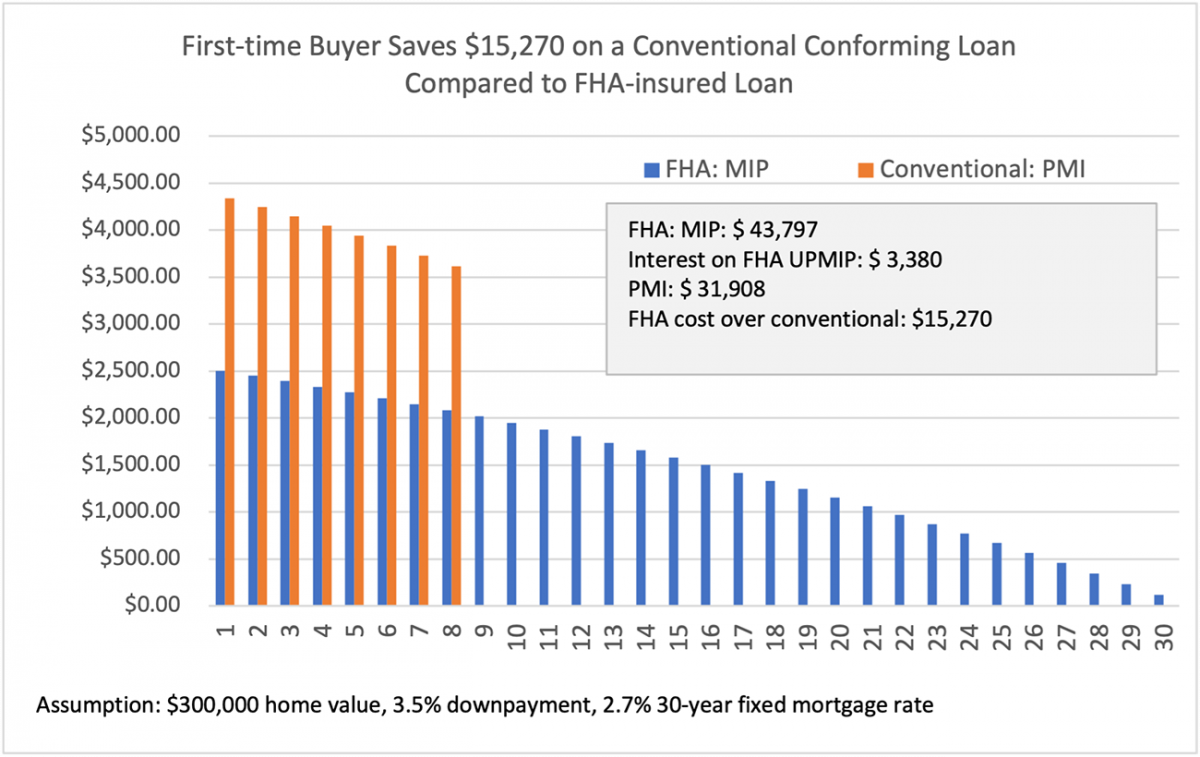More First-time Buyers are Obtaining Conventional Instead of FHA Financing
FHA mortgage insurance is more expensive than private mortgage insurance
One reason why first-time buyers are obtaining conventional financing and not FHA financing is the higher payment due to mortgage insurance. Borrowers who are first-time buyers and who meet income guidelines (income is no more than 80% of area median income) could also obtain a 97% loan-to-value conventional conforming mortgage where the payment to investors who purchase the mortgage backed securities are guaranteed by Fannie Mae and Freddie Mac.
In the case of mortgages that meet Fannie Mae/Freddie Mac guidelines, the borrower does not have to pay private mortgage insurance (PMI) when the equity reaches 80%. In the case of a FHA-insured mortgage, a borrower obtaining a 30-year fixed-rate mortgage with 96.5% LTV will continue paying a monthly mortgage insurance premium (MIP) for the life of the loan. In addition, the borrower pays an upfront mortgage insurance premium (UPMIP) at the time the mortgage is obtained, although the UPMIP can be rolled into the loan.
I calculated the cost difference on a $300,000 home financed with a 2.7% 30-year fixed rate mortgage and assuming a PMI of 1.5%. The cost difference is $15,270. A borrower obtaining an FHA-insured mortgage pays $43,797 over the life of the loan in mortgage insurance (MIP) compared to only $31,908 in the case of loan backed by Fannie Mae/Freddie Mac where the borrower stops paying the monthly private mortgage insurance (PMI) on year 9 when equity reaches 20% the prior year. In addition, the borrower obtaining an FHA-insured mortgage pays an interest of $3,380 by rolling into the loan the upfront mortgage insurance payment (UPMIP) of $5,356 (0.85% of the base loan amount of $289,500).
Increasing role of GSEs in providing 3% down payment mortgages
Fannie Mae and Freddie Mac started offering financing for mortgages with a 3% down payment in December 2014, to increase homeownership among households who can afford to pay the monthly mortgage but lack the 20% down payment. The programs serve low income households with income of up to 80% of the area median income.
Fannie Mae’s Home Ready program(link is external) is limited to borrowers with an income of up to 80% of the area median income. Fannie Mae’s HomeReady mortgage requires 25% mortgage insurance coverage on 90.01 to 97% LTV loans. The loan level price adjustments that increase the cost of a loan (based on a combination of down payment and credit score) are also waived for buyers with credit scores of at least 680. However, no income eligibility limits are required in its Standard 97% LTV Loan program.
Freddie Mac’s Home Possible(link is external) program also provides 97% LTV loans, and the program is limited to borrowers whose income is up to 80% of the area median income. Also, even non-first-time buyers can take advantage of this program as long as they meet the income eligibility requirement. At least one of the borrowers must also occupy the property as a primary residence.
1 The REALTORS® Confidence Index Survey asks Realtors® about the characteristics of their last closed transaction for the month, which can be considered a random same of closed transaction. The RCI survey asks “Was the buyer a first-time buyer?” and “What was the type of financing” among respondents who reported that the buyer used mortgage financing. The tabulations on the type of financing obtained by first-time buyers has about 500 responses each month.


 Facebook
Facebook
 X
X
 Pinterest
Pinterest
 Copy Link
Copy Link







